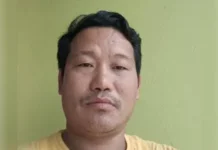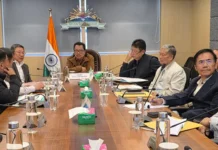They loved him, they hated him, they feared him; none could ever ignore him. Taro Chatung was the common man’s journalist.
[ Rup J Pater ]
Year: Early 21st century
Time: 6:40 pm
Deadline: 7:05 pm
To go on air: 7:15 pm
Days were there when there was no news… or not enough worth reporting. Print subeditors would rub their receding hairlines and make optimum use of the worldwide web to fill their respective four pages. For me it was a Herculean task filling the 15-minute audiovisual news-slot at hand.
By the way, www.com still ain’t a lifesaver for audiovisual media in terms of copy-pasting!
On the edit suite, I was done with all the video reports of the day – organizing, clipping, cutting, narrating, etc. There were about four stories. After editing and setting all four on the timeline, I still had a little more than three minutes of time-space to fill.
There were no more stories coming in.
Being trained in print, audiovisual medium wasn’t easy for me. Had it been for print, I could have played with the sentences – reconstructing, rephrasing, realigning – even resizing the fonts on a lazy day and fill up every darn inch of a page! But I just couldn’t manipulate the visuals at hand to extend the episode for another three minutes. ‘CID’ or ‘Saas Bhi Kabhi Bahu Thi’ type of soaps weren’t that popular then, for inspiration. Nor had the national-regional news channels caught up with the now mandatory repetitive visuals with equally repetitive narratives plus the horror-film stolen music to go with, to learn from.
The clock showed 6:50 pm. Fifteen minutes to deadline.
Tensed, I started reviewing the ‘bytes’ of people in the raw (not RAW) footages, hoping to find something important or worth adding in the newsreel. My bad, the more I saw the more I felt like deleting a few bytes from the final timeline instead! I was stuck… surrendered. Almost.
Enter my saviour…. my boss – Taro Chatung.
Those days I was working with the Echo of Arunachal (EoA). With only four newspapers published from Itanagar, all were doing fine – content-wise. On the electronic front, a few houses tried their hands at producing newsreels aired on DDK Itanagar. Except for one, the rest faded away, unable to sustain financially.
Even today it isn’t easy for electronic media; it was harder then. Unlike what many may believe, DDK wasn’t paying these private producers to air their newsreels. It was the other way round. Producers paid DDK for the slot allotted to them to air their episodes. It didn’t come cheap, and took its toll on the producers, who had neither sponsors nor advertisers.
If not for Taro Chatung, his inimitable style of working, and his never-say-die attitude, ‘News & Views’ wouldn’t have survived. It not only survived and thrived, it made a cult of a generation!
Today I can dare say that DDK Itanagar not only thrived but survived a difficult phase because of Taro Chatung’s ‘News & Views’. When cable TV ruled the roost and DTH service providers were changing the concept of TV viewing, DDK was stuck with its traditional antenna atop long bamboo poles. ‘News & Views’ ensured that these bamboo poles stayed put for at least another five years (2000-2005).
“So, what’s up, Rup? Hope today’s episode is ready,” Chatung sir queried as he pulled up a chair beside me.
When I told him that I still needed one more story to complete the slot, he fumed first. Then he smiled, nonchalantly picked up his camera, and walked out to his trusted car – yes the red Maruti 800. As he drove out, I heard him shout, “Five minutes!”
Chatung sir was made of a different mettle. He had stories running in his blood. All he needed was visuals, and he had all the energy in the world to go hunting for these visuals.
Seven minutes to deadline.
I vividly remember the evening he walked into my office at the EoA. Without much ado, he came straight to the point. He wanted me to join ‘News & Views’ as a part-timer.
“You may not know, Rup, but I know people laugh behind my back. They laugh at my Hindi, they laugh at my style of narration, and they make fun of my presentations. I don’t care, mind you, but the times are changing and I need to accept it. After giving a lot of thought, I have decided to leave the script, narration and presentation part to someone with good language skills, who can also double up as an anchor. You fit my bill,” was his explanation.
Before I could react, he pulled out a paper and placed it on the table. A ‘letter of acceptance’. Neatly typed, I just had to sign.
As I pondered, he pointed towards a blank on the letter and said, “Here, I have kept this blank. It is up to you to fill… the monthly remuneration that you expect, based on your assumption of your capability, eligibility and productivity.”
It wasn’t a bad proposal. I could keep my present job. Give only two hours of the day in the evening to ‘News & Views’ and earn both ways! The only confusing point was what to fill in the blank! I couldn’t ask the world from Chatung sir, knowing how hard he worked and how less he earned; nor did I want to work for less…. at least not lesser than what I was getting.
Next day, I was at the rented office-cum-residence of Chatung sir in Abotani Colony with the letter signed. As I held my breath, he glanced at the paper – not even for a full second, smiled, and held out his hand.
“Welcome to ‘News & Views’!”
For those wondering, with much courage I had scribbled on the blank – Rs 10,000! Those years it was a handsome perk and a few grands more than what I was getting from the job at hand. Chatung sir didn’t even bat an eyelid! His confidence outshone all others.
Three minutes to deadline.
As the brakes screeched outside, I knew Chatung sir was back…. with a story only a Taro Chatung could do. With the audiovisuals on his VHS tape, he set on the job of editing. When it comes to linear editing, I can well say that there was none in the state to match Chatung sir in speed and accuracy. Now that linear editing is history, there would be none.
Silence prevailed, except for the whirling-grinding sounds of the VCR machines that Chatung sir pushed to the limits. My eyes were on the clock though.
Two minutes past deadline.
“Deadlines at times are meant to be broken,” he laughed as he zoomed off in his 800, with the final VHS tape, to DDK.
As I watched ‘News & Views’ that evening, the genius of Taro Chatung became obvious all the more. The last story of three minutes was the story of the day, drawing attention and appreciation from all and sundry. And the saying that ‘a good journalist creates a story when there’s none’ dawned on me.
Location: Ganga market. Subject: Clock tower.
Chatung sir thrusts his camera randomly at people, asking them what time of the day it is. When they tell the time, consulting their watches, Chatung sir counters with “Aapka ghadi kharab hai tu…” and “Aapka ghadi sahi hai na woh clock tower ka ghadi sahi hai?”
The tower-clock was not budging from 2:15 pm since months.
The best part was when Chatung sir confronted an elderly policeman with the question: “Aap toh full uniform me hai. Kahan se aa raha hai?”
“Office se. Chutti ho gia.”
“Arey aapka office 2:15 me chutti hotai kya?”
“Naitoh. Six baji paar ho gia abhi. Chutti toh hoga na…”
“Kun bola six bajgia? Aap woh clock tower ko dekhiye toh, sirif 2:15 hi hua hai.”
“Who toh faltu hai. Daily utna hi bajta hai!”
For reasons best known to it, DDK stopped airing all news-based programmes produced by private parties on its channels. Chatung sir’s ‘News & Views’ had an untimely and sudden death, ending an era of daring, innovative and intriguing journalism – never seen or will be in Arunachal Pradesh.
I had left ‘News & Views’ much before it went off air, as I realized that viewers wanted only him on the screen. They didn’t want a picture-perfect script or camera-centric scholastic Hindi for narration. They wanted on screen someone who spoke, articulated and summarized like them… a common Arunachalee, albeit with some uncanny power that is not common. They wanted a common man with uncommon power… not to punch but to question. Chatung sir it was… a superman of sorts. People on other side of the fence loved him, hated him, feared him, but just couldn’t ignore him. He was the common man’s journalist. No one was or will be… in his shoes.
Well, as far as the clock tower in Ganga is concerned, can’t say for how long but it started working the next day.
“Dekkha Rup… kuch nai ho k bhi kuch toh hua hai na!” he had quipped to me days later, in his trademark humour, which… well, can’t be copy-pasted.
Year: About two decades into 21st century
Time: 10:30 am
Date: 26 October, 2019
… Line dead
… On air forever



